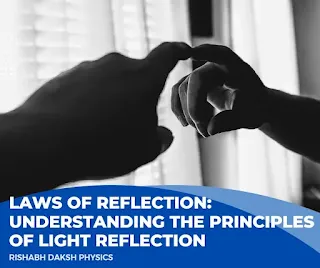Laws of Reflection
Introduction
In the world of optics, the laws of reflection play a fundamental role in understanding how light interacts with various surfaces. Whether you're a student of physics, a photography enthusiast, or simply curious about the behavior of light, having a solid grasp of the laws of reflection is essential. This comprehensive guide will delve into the principles governing light reflection, providing you with a clear understanding of this intriguing phenomenon.
 |
| Laws of Reflection: Understanding the Principles of Light Reflection |
What is Reflection?
Reflection is the process by which light waves bounce off a surface, changing direction without being absorbed or transmitted through it. This phenomenon occurs when light encounters an interface between two different materials, such as air and glass, or air and water. Understanding the laws that govern reflection allows us to predict and explain how light behaves when it interacts with mirrors, lenses, and other reflective surfaces.
Also Read:
- Taylor Series
- Sine Function
- Derivative Function Calculus
- What is Electric Current ? Electric Flux, Electric Dipole Moment and Electrical Energy | Physics Class 12 CBSE Board Chapter 3 | Current Electricity Notes and PDF for free
- CBSE Class 12 Physics notes All Chapters
- Unit and Dimensions of Class 11 Physics
- Laws of Reflection
The First Law of Reflection
The first law of reflection states that the incident angle of a light ray is equal to the angle of reflection. This means that when a light ray strikes a surface and reflects off it, the angle at which it approaches the surface (the incident angle) will be equal to the angle at which it departs from the surface (the angle of reflection). This law holds true for all types of surfaces, including flat, curved, and irregular surfaces.
Example: Imagine a beam of light approaching a mirror at a 30-degree angle relative to the mirror's surface. According to the first law of reflection, the reflected beam will also make a 30-degree angle with the mirror's surface, but on the opposite side.
The Second Law of Reflection
The second law of reflection states that the incident ray, the reflected ray, and the normal (a line perpendicular to the surface at the point of incidence) all lie on the same plane. In simpler terms, this means that the incident ray, the reflected ray, and the line perpendicular to the surface of reflection all lie in a flat, two-dimensional plane.
Example: Suppose a light ray strikes a mirror at a 45-degree angle relative to the surface. The normal line will be perpendicular to the mirror's surface at the point of incidence. The reflected ray will then lie in the same plane as the incident ray and the normal, adhering to the second law of reflection.
Understanding the Angles of Reflection
To fully comprehend the laws of reflection, it's essential to understand how the angles are measured. The incident angle is the angle between the incident ray and the normal line, while the angle of reflection is the angle between the reflected ray and the normal line.
Real-Life Applications of the Laws of Reflection
The laws of reflection have numerous practical applications in our everyday lives. Let's explore a few of these applications:
Mirrors
Mirrors are perhaps the most common example of reflective surfaces. They work by precisely reflecting light according to the laws of reflection. Whether you're applying makeup, checking your appearance, or using mirrors in telescopes and microscopes, understanding the principles of reflection is crucial to optimizing the mirror's performance.
Photography and Optics
In the field of photography and optics, the laws of reflection are vital for understanding the behavior of light when it interacts with lenses, prisms, and other optical instruments. By comprehending how light reflects off different surfaces, photographers and scientists can manipulate and control the path of light to achieve desired effects or capture clear images.
Architecture and Interior Design
Architects and interior designers often incorporate reflective surfaces strategically to enhance lighting in buildings and spaces. By understanding the laws of reflection, they can create visually appealing designs that optimize natural and artificial lighting, giving the illusion of more space and adding a touch of elegance.
Safety Measures
The laws of reflection also find applications in safety measures, such as road signs, reflectors, and retroreflective materials. These materials reflect light back toward the source, making them highly visible even in low light conditions. This ensures the safety of pedestrians, cyclists, and drivers by enhancing visibility and reducing the risk of accidents.
Conclusion
Understanding the laws of reflection is paramount for comprehending the behavior of light when it encounters various surfaces. By grasping the first and second laws of reflection, you can predict the direction and angle at which light rays will reflect, enabling you to work with mirrors, lenses, and other reflective materials more effectively. Moreover, these laws have far-reaching applications in photography, architecture, safety measures, and numerous other fields.
So, whether you're exploring the wonders of physics, pursuing a career in optics, or simply intrigued by the nature of light, a firm grasp of the laws of reflection is an invaluable asset. By leveraging the knowledge gained from this guide, you can delve deeper into the fascinating realm of optics and confidently apply the principles of reflection to enhance your understanding of the world around us.





.png)

No comments:
Post a Comment
Have Any Query ? Ask Here or Comment...